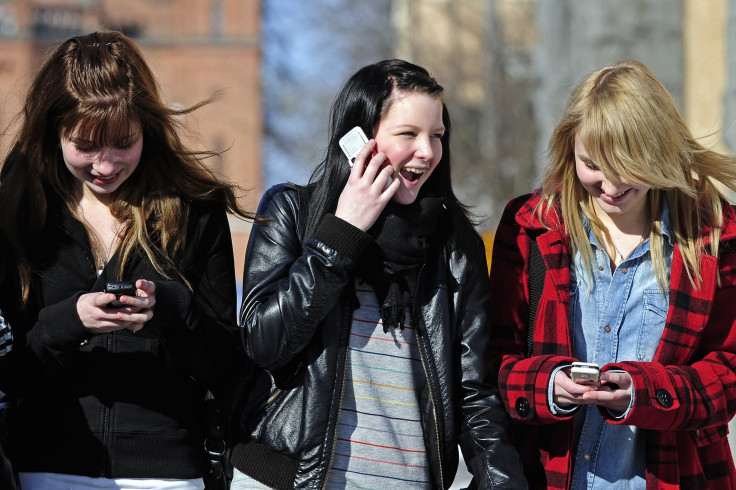Teen Dating Trends 2015: Technology Can Make Relationships Closer But Facilitate Abuse, Report Finds

Gone are the days of teenagers "going steady" with their boyfriends and girlfriends. In 2015, teen couples are going online instead.
Young people's relationships in the early 21st century are shaped by a host of devices, social media websites and friendship networks, according to a report released Thursday by the Pew Research Center. For Americans between the ages of 13 and 17, technology plays a critical role in all stages of dating, which can be both good and bad for mental health.
“Digital platforms are powerful tools for teens for flirting, wooing, connecting with and even showing off a romantic partner,” Pew's associate director for research, Amanda Lenhart, said in a news release. “But even as teens enjoy greater closeness with partners and a chance to display their relationships for others to see, mobile and social media can also be tools for jealousy, meddling and even troubling behavior.”
Flirting On Facebook
Pew found that more than half of teenagers with relationship experience said social media websites like Facebook, Instagram and Twitter helped them feel more up to date on their partner's life. About the same number of respondents said they thought the platforms gave them an opportunity to show others how much they care about their other half. Boys tended to have a more positive view of this scenario than girls did.
When a relationship is in its early stage, teenagers use technology to flirt nearly as often as simply talking to their crush in person. Pew found that 55 percent of all teens said they expressed their interest in others "IRL" -- in real life -- while 50 percent said they friended them on social media. About 47 percent said they flirted by "liking" or commenting on their crush's content. One teen told Pew he just types "a bunch of emojis under her photo."
That means that, yes, the era of romantic mixtapes is over. Only 11 percent of teens said they put together music playlists to show their affection.
Texting Every Hour
But teenagers haven't completely abandoned human contact. Hanging out together in person and out of school was the third most common way those with dating experience said they spent time with their significant other, following talking on the phone and text messaging. In 2010, Nielsen found that the average teenager sent or received about 3,300 text messages a month. About 85 percent of dating teens told Pew they believed their partner should check in at least once a day, with 11 percent saying they expected to hear from them once an hour.
The ease of being in constant contact can sometimes backfire. The term "textual harassment" arose in 2010, referring to people who abuse their partners over digital media. Katie Ray-Jones, president of the National Domestic Violence Hotline, told the Washington Post last year about a case where a boy hired his friends to text his girlfriend while he slept and went to work.
Other types of uncomfortable situations also arise on social media. About 25 percent of all teens said they'd blocked someone because of unwanted flirting, and more than a quarter of those with relationship experience told Pew that posts online made them feel "jealous or unsure" about their relationship. One-fifth said their significant others had read their text messages without permission, while 13 percent said their partners made them turn over their passwords.
The Dreaded Text Breakup
Technology, naturally, also plays a role in breakups. In theory, teenagers mostly kept it traditional, ranking in-person breakups the "most socially acceptable" way to end a relationship. But in practice, 27 percent of dating teens said they'd dumped someone via text message -- about the same number who had broken up with their partner over the phone. Another indication that text breakups aren't unusual: That was how former One Direction member and teen idol Zayn Malik reportedly broke up with his fiancée, Perrie Edwards from the band Little Mix, in August.
“I think that texting is better because you’re not really in person," one middle schooler told Pew. "Like one time I told her you're just kind of being too clingy and it's getting really annoying. And she like threw a book at me, so that's why it's probably better to do texts.”
Teen communications can become hurtful after breakups, as well. About 14 percent of teens with relationship experience told Pew their partner or ex said mean things via the Internet or cell phone after they split. About one-tenth of respondents said they'd accessed a partner or ex's social media accounts, and the same amount said they changed or deleted that person's profile.
And as for the friends glued to their newsfeeds watching all of this drama play out? Teen daters' opinions on them were split. About 63 percent of teen daters said they thought social media enabled people to support them after breakups, and the other 37 percent disagreed.
The Pew report was based on responses from about 1,000 teens collected over the past year. About 93 percent of the respondents said they considered themselves straight.
© Copyright IBTimes 2024. All rights reserved.






















